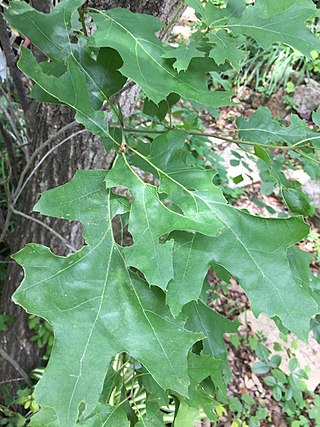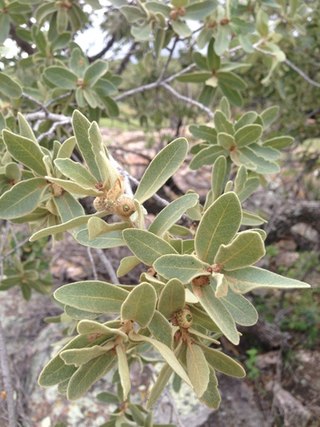
An oak is a hardwood tree or shrub in the genus Quercus of the beech family. They have spirally arranged leaves, often with lobed edges, and a nut called an acorn, borne within a cup. The genus is widely distributed in the Northern Hemisphere; it includes some 500 species, both deciduous and evergreen. Fossil oaks date back to the Middle Eocene. Molecular phylogeny shows that the genus is divided into Old World and New World clades, but many oak species hybridise freely, making the genus's history difficult to resolve.

Quercus muehlenbergii, the chinquapinoak, is a deciduous species of tree in the white oak group. The species was often called Quercus acuminata in older literature. Quercus muehlenbergii is native to eastern and central North America. It ranges from Vermont to Minnesota, south to the Florida panhandle, and west to New Mexico in the United States. In Canada it is only found in southern Ontario, and in Mexico it ranges from Coahuila south to Hidalgo.

Quercus velutina, the black oak, is a species of oak in the red oak group, native and widespread in eastern and central North America. It is sometimes called the eastern black oak.

Quercus virginiana, also known as the southern live oak, is an evergreen oak tree endemic to the Southeastern United States. Though many other species are loosely called live oak, the southern live oak is particularly iconic of the Old South. Many very large and old specimens of live oak can be found today in the Deep South region of the United States.

Quercus laevis, the turkey oak, is a member of the red oak group of oaks. It is native to the southeastern United States. The name turkey oak derives from the resemblance of the leaves to a turkey's foot. A Turkish and southern European species Quercus cerris is also commonly referred to as Turkey oak, so Quercus laevis is sometimes referred to as American turkey oak to distinguish it from the European species.

Quercus wislizeni, known by the common name interior live oak, is an evergreen oak, highly variable and often shrubby, found in many areas of California in the United States continuing south into northern Baja California in Mexico. It generally occurs in foothills, being most abundant in the lower elevations of the Sierra Nevada, but also widespread in the Pacific Coast Ranges—where since 1980 it has been known as a separate species Quercus parvula—and the San Gabriel Mountains. It was named for its collector, Friedrich Adolph Wislizenus (1810–1889).

Quercus fusiformis, commonly known as escarpment live oak, plateau live oak, plateau oak, or Texas live oak, is an evergreen or nearly evergreen tree. Its native range includes the Quartz Mountains and Wichita Mountains in southwestern Oklahoma, through Texas, to the Mexican states of Coahuila, Tamaulipas, and Nuevo León.

Quercus douglasii, known as blue oak, is a species of oak endemic to California, common in the Coast Ranges and the foothills of the Sierra Nevada. It is California's most drought-tolerant deciduous oak, and is a dominant species in the blue oak woodland ecosystem. It is occasionally known as mountain oak and iron oak.

Quercus texana, commonly known as Nuttall's oak, is a fast-growing, large deciduous oak tree.
This is a list of plants which includes trees and other herbs, vines, climbers, lianas, shrubs, subshrubs that are native or endemic, found in Cuba.

Quercus arkansana, the Arkansas oak, is a species of oak tree. It is native to the southeastern United States. It is threatened by use of its habitat for pine plantations, clearing of land, and diebacks that may be caused by drought.

Quercus buckleyi, commonly known as Texas red oak, Buckley's oak, or Spanish oak is a species of flowering plant. It is endemic to the southern Great Plains of the United States.

Quercus lusitanica, commonly known as gall oak, Lusitanian oak, or dyer's oak, is a species of oak native to Portugal, Spain and Morocco. Quercus lusitanica is the source of commercial nutgalls. These galls are produced by the infection from the insect Cynips gallae tinctoriae. They are used for dyeing.
Quercus oleoides, with Spanish common names encina or encino, is a Mesoamerican species of oak in the southern live oaks section of the genus Quercus. It grows in dry forests and pastureland of eastern and southern Mexico and much of Central America, from Guanacaste Province in Costa Rica north as far as the State of Tamaulipas in northeastern Mexico.

Quercus geminata, commonly called sand live oak, is an evergreen oak tree native to the coastal regions of the subtropical southeastern United States, along the Atlantic Coast from southern Florida northward to southeastern Virginia and along the Gulf Coast westward to southern Mississippi, on seacoast dunes and on white sands in evergreen oak scrubs.

Quercus chihuahuensis, the Chihuahua oak, is a species of oak in the beech family. It is native to the region from extreme western Texas west to Sonora, Mexico, and south to Zacatecas and San Luis Potosí. It grows mostly at mid elevations, from 400–2,000 metres above sea level, in forests mixed with various pines and other oaks. It is one of the dominant species of the Sierra Madre Occidental in Chihuahua and Sonora.

Quercus porphyrogenita is a species of oak in the family Fagaceae, native to northeastern Mexico.

Quercus margarettae, the sand post oak or dwarf post oak, is a North American species of oak in the beech family. It is native to the southeastern and south-central United States from Virginia to Florida and west as far as Texas and Oklahoma. There are historical reports of the species growing in New York State, but it has not been seen there in years.

Quercus jonesii is a species of oak tree native to Mexico. It is commonly known as palo manzano. It is placed in Quercus section Lobatae.


















